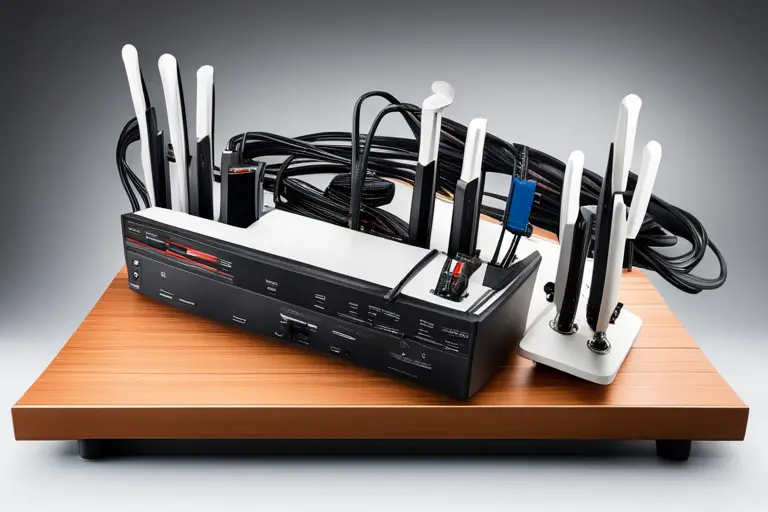Are you tired of slow internet speeds and weak signals? It’s time to upgrade your Wi-Fi equipment! A new router can make a world of difference in your internet experience, providing faster speeds, better coverage, and more reliable connections.
But with so many options available, it can be overwhelming to choose the right one for your needs. That’s where this guide comes in.
We’ll walk you through the importance of upgrading your router, help you understand your Wi-Fi needs, and provide tips for selecting the best router for you.
So, let’s get started and say goodbye to buffering and slow loading times!
The Importance of Upgrading Your Router
Don’t underestimate the power of upgrading your router – it’s like giving your Wi-Fi a shot of espresso! Upgrading your router is crucial if you want to enjoy faster internet speeds, better Wi-Fi coverage, and a more reliable network.
In fact, your router is the backbone of your internet connection, and a slow or outdated one can drag down your entire network. By upgrading your router, you can take advantage of the latest Wi-Fi technology, such as Wi-Fi 6 or 802.11ax, which can deliver faster speeds, better security, and improved performance in crowded areas.
You’ll also get more advanced features, such as parental controls, guest networks, and QoS (Quality of Service) settings, which allow you to prioritize certain devices or applications for a better online experience. So, whether you’re streaming movies, gaming, or working from home, upgrading your router can make a world of difference.
Understanding Your Wi-Fi Needs
Understanding what you need from your internet can be confusing, but it’s important to consider factors like the number of devices in your household and the types of activities you use the internet for.
If you have a large family with multiple devices, you’ll need a router that can handle all the traffic. On the other hand, if you’re a single person using the internet mainly for streaming videos or browsing the web, you may not need as powerful a router.
Another important factor to consider is the size of your home. If you have a small apartment, a basic router may suffice. However, if you have a larger home with multiple floors, you’ll need a router with a stronger signal that can reach all areas of your house.
Additionally, if you have a home office or need to access the internet from your backyard, you may want to consider a router with a wider range or mesh network capabilities.
Understanding your Wi-Fi needs is crucial in choosing the right router that can provide reliable, fast internet for all your devices and activities.
Types of Routers Available
There’s a plethora of router options to choose from, each with different features and capabilities to suit your specific needs. Here are some of the most common types of routers available:
1. Single-band routers: These routers operate on the 2.4 GHz frequency band and are typically the most affordable option. They’re best suited for small homes or apartments with minimal interference from other wireless devices.
2. Dual-band routers: These routers operate on both the 2.4 GHz and 5 GHz frequency bands, which allows for faster speeds and better performance in larger homes or spaces with more wireless devices.
3. Mesh routers: These routers consist of multiple nodes that work together to create a seamless Wi-Fi network throughout your home. They’re best suited for large homes or spaces with multiple floors and thick walls that can interfere with the Wi-Fi signal.
Ultimately, the type of router you choose will depend on your specific needs and budget. Consider your home size, number of devices, and internet usage when making your decision.
Features to Look for in a New Router
If you’re looking to upgrade, you’ll want to keep an eye out for some key features when choosing a router.
The first feature to consider is the Wi-Fi standard. You’ll want to make sure the router you choose supports the latest standard, which is currently Wi-Fi 6. This standard delivers faster and more reliable connections, especially in crowded environments like apartments or office buildings. While Wi-Fi 6 routers may be more expensive, the investment is worth it if you want the best performance.
Another feature to look for is the number of antennas. More antennas mean better coverage and faster speeds. A router with multiple antennas can also handle more devices connected at once without slowing down.
Additionally, you’ll want to consider the range of the router. If you have a large home or need coverage outside, you’ll want a router with a longer range. Some routers even come with mesh network capabilities, which allows you to add additional units to extend coverage throughout your home.
By considering these features, you’ll be able to choose a router that meets your specific needs and provides the best Wi-Fi experience for your home.
Setting up Your New Router
To get the best out of your home network, start by configuring your new router just for you! The first step is to connect your new router to your modem using an Ethernet cable. Then, plug the router into a power source and turn it on.
You can usually find the default network name and password on a sticker on the bottom or back of your router. Connect to the network using these credentials and open a web browser to access the router’s configuration page.
Once you’re on the configuration page, you can change the default network name and password to something more personalized and secure. You can also customize other settings such as parental controls, guest network access, and channel selection.
It’s important to make sure your router’s firmware is up to date, as this can improve performance and security.
With a few simple steps, you can have your new router up and running in no time, and enjoy faster and more reliable Wi-Fi throughout your home.
Troubleshooting Common Issues
Having trouble with your home network? Let’s troubleshoot some common issues together!
One of the most common issues with a new router is slow internet speed. If you’re experiencing slow speeds, try restarting both your router and modem. This can often fix the problem.
If that doesn’t work, check to see if your router is in a central location and not obstructed by any objects. Walls, furniture, and even other electronics can interfere with your Wi-Fi signal.
Another issue could be a weak signal. If your signal is weak, try moving your router closer to the devices that are having trouble connecting. You can also try changing the channel your router is on, as interference from other devices can cause a weak signal.
Lastly, make sure your router’s firmware is up to date. Manufacturers often release updates that can improve performance and fix bugs.
By following these troubleshooting tips, you can have a smoother and faster Wi-Fi experience with your new router.
Maximizing Your Wi-Fi Experience
Optimizing the performance of your home network can greatly enhance your online experience, allowing you to stream high-quality videos and play online games with ease.
To maximize your Wi-Fi experience, start by placing your router in a central location away from obstructions such as walls and metal objects. This will ensure that the signal can reach all areas of your home without interference.
Another way to improve your Wi-Fi experience is to regularly update your router’s firmware. This will ensure that it’s running the latest security protocols and performance enhancements.
Additionally, you can consider upgrading to a newer router model that supports the latest Wi-Fi standards for faster speeds and stronger signal strength. By taking these steps, you can enjoy a faster, more reliable internet connection and make the most of your online activities.
Frequently Asked Questions
What are the potential security risks associated with using an outdated router?
Using an outdated router can leave your network vulnerable to security risks such as malware, hacking, and unauthorized access. It’s important to regularly update your router to ensure the latest security features are in place.
Can I use my current modem with a new router or do I need to upgrade both?
You can use your current modem with a new router, but it’s important to make sure they’re compatible. Check the specifications of both devices and confirm that they work together before making the upgrade.
Are there any specific brands or models of routers that are better for streaming video or online gaming?
For streaming video or online gaming, look for routers with “AC”in the name, like the Netgear Nighthawk AC1900 or Asus RT-AC88U. These routers have faster speeds and better range for high-bandwidth activities.
How do I know if my internet service provider (ISP) is limiting my Wi-Fi speed?
To check if your ISP is limiting your Wi-Fi speed, run a speed test using a wired connection to your modem. If speeds are significantly lower than what you’re paying for, contact your provider to troubleshoot or upgrade your plan.
Is it necessary to purchase a router with the latest Wi-Fi standard, or will an older standard suffice?
You should consider purchasing a router with the latest Wi-Fi standard for optimal performance. Older standards may work, but newer ones offer faster speeds and better coverage.
Conclusion
Congratulations on upgrading your Wi-Fi equipment! You’ve taken a crucial step towards improving your internet experience.
With your new router, you can now enjoy faster speeds, stronger connections, and better coverage.
Remember that understanding your Wi-Fi needs and choosing the right router for you are key factors in maximizing your Wi-Fi experience. Take the time to research and compare different router models, and don’t be afraid to seek help from professionals if needed.
By doing so, you can ensure that your Wi-Fi network is reliable, secure, and tailored to your specific needs.
Happy browsing!

Hey there, tech enthusiasts! I’m your go-to content writer, delving into the fascinating world of technology hacks. Get ready to unlock mind-blowing secrets and discover innovative solutions through my engaging and insightful blogs.


